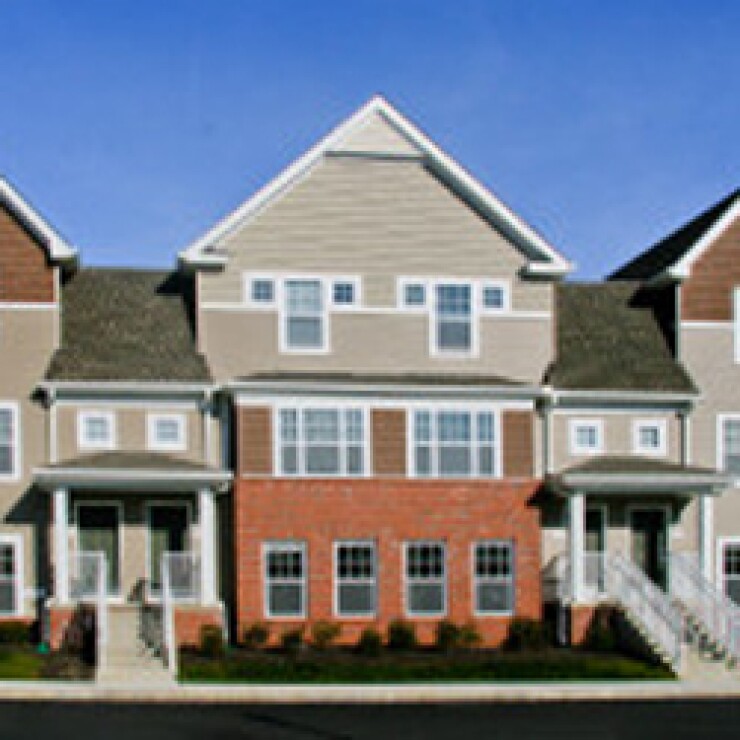
Multifamily debt has boomed in recent years as the single-family market slowed. But the biggest government multifamily construction program in the country is a potential target of federal tax reform, and the industry is continuing to fight to keep the Low Income Housing Tax Credit away from reformers' knives.
With the glacial pace Congress moves at these days, the tax credit, a permanent program that would have to be specifically terminated by legislators, probably isn’t in danger this year. But it has been suggested for elimination often enough to alarm the people who work with the credits.
"We’re extremely worried about it," says Thom Amdur, president of the
"Our efforts have paid off, in part," he adds, noting that a
Also, Rep. Patrick Tiberi, R-Ohio, and Rep. Richard Neal, D-Mass., along with a
(The floors would mean that investors in a project are guaranteed an
The bill is now with the House Ways and Means Committee.
Amdur favors the Tiberi-Neal bill, saying eliminating floating-rate floors would regularize the flow of the credits. Also, he says, "It will generate a little more equity" in deals.
The latest to weigh in to
Foreclosures on units with tax credit finance have been less than 1%, they note. Since the program's inception in 1986, they say, the LIHTC has helped build or rehabilitate 2.6 million affordable multifamily rentals, about 100,000 units a year.
The president’s Economic Recovery Advisory Board, chaired by former Fed chairman Paul Volcker, included the tax credit as a candidate for elimination in its 2010 report on tax reform. A table in the report suggests cutting LIHTC would eliminate $61 billion in lost revenues over a decade. Some feel housing vouchers would be better than the credits, the report notes.
"That’s pretty debatable," says Amdur, whose trade group represents for-profit and nonprofit multifamily developers. "There's a lot of research since then that shows it is the most efficient affordable housing delivery device." President Obama himself has singled out the housing tax credit as one that should be saved, Amdur notes. "This administration has been particularly supportive of the credit," he says.
Demand for multifamily remains high. Multifamily originations decreased by 17% in the first quarter, partly due to bad weather, but sector debt
It seems incongruous (pardon the congressional pun) to cut a key part of the multifamily housing finance system while multifamily debt is closing in on the $1 trillion mark. And while the tax credit program has a lot of moving parts, it has been a significant success.
The tax credits get private investors to help finance affordable multifamily units, new construction and rehab. It is a complex effort among the federal government, states, real estate developers, syndicators and investors. The program is overseen by the Internal Revenue Service and administered by state housing finance agencies.
The system works if the private investors can use the dollar-for-dollar tax credit, which they can usually obtain for less than $1 apiece through the syndicators. However, some companies don't need a tax break because they don’t owe any taxes. And some companies don't need them any more after a change in status. Fannie Mae was one of the biggest investors in multifamily tax credits, but once it became a ward of the federal government it got out of the market.
There's a decent amount of benefit to be had. The credit is allocated to the state agencies on a per capita basis, $2.30 a head currently. So a place like my home state of New Jersey would qualify for some $20 million in tax credits a year (and more in coming years if the state's population increases).
Developers propose affordable rental deals to the state agencies, which award credits according to their own ratings systems. The deals are underwritten several times, Amdur says—by the prospective investors, the state agencies and lenders (if there are any in on the deal).
After the awards are made by the state agencies, conduit-like entities called syndicators sell the credits to investors at market rates. (
Tax credits don't finance an entire development. Instead they are part of the complicated affordable housing finance toolkit which can include sources like the affordable housing programs of the Federal Home Loan Bank System, federal HOME funds, federal Community Development Block Grants and state tax credits.
Getting back to my home state, the New Jersey Housing and Mortgage Agency has used tax credit financing twinned with federal CDBG Hurricane Sandy recovery money for a $45 million development called
Many LIHTC projects have even more of a patchwork quilt of financing than this one has. But when they are finally done, they can look like financial works of art.
Mark Fogarty, Editor at Large at National Mortgage News, brings more than 30 years of experience to his analyses of the mortgage market.





